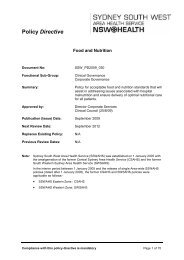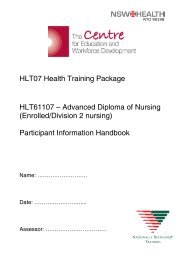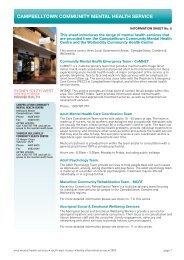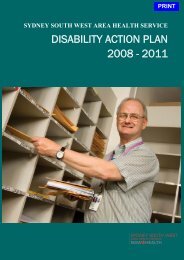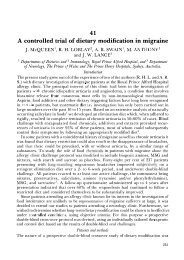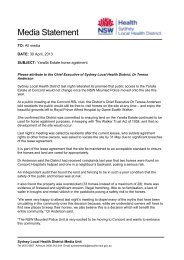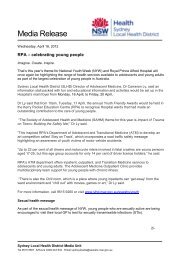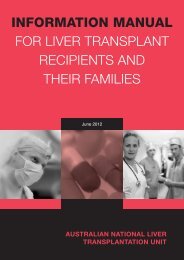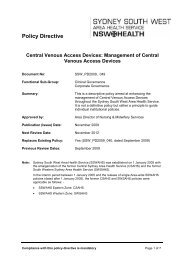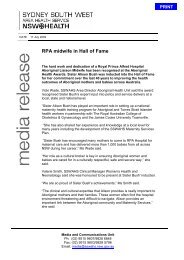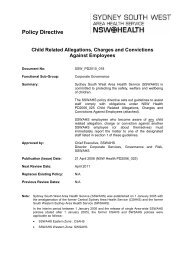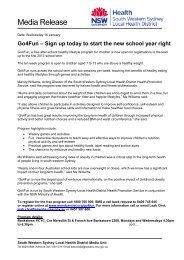Heparin and Warfarin - Sydney South West Area Health Service
Heparin and Warfarin - Sydney South West Area Health Service
Heparin and Warfarin - Sydney South West Area Health Service
You also want an ePaper? Increase the reach of your titles
YUMPU automatically turns print PDFs into web optimized ePapers that Google loves.
<strong>Sydney</strong> <strong>South</strong> <strong>West</strong> <strong>Area</strong> <strong>Health</strong> <strong>Service</strong><br />
Guideline No: SSW_GL2007_010<br />
Date issued: November 2007<br />
Severe Renal Impairment<br />
levels (see below) until a stable level is achieved, with<br />
less frequent monitoring in situations where long term<br />
therapy is employed.<br />
(eCl CR < 30 ml/min)<br />
Avoid in most circumstances, unless in close<br />
consultation with a Renal Physician <strong>and</strong> / or<br />
Haematologist. If used, Enoxaparin 1 mg/kg/day with<br />
daily or second daily monitoring of anti-Xa levels (see<br />
below) until a stable level is achieved.<br />
Therapeutic Dosing (once daily – not suitable for coronary artery<br />
syndromes):<br />
Normal Renal Function<br />
(eCl CR > 60 ml/min)<br />
Enoxaparin 1.5 mg/kg daily (maximum 150 mg dose). If<br />
the patient’s weight is > 100 kg, twice daily 1 mg/kg is<br />
recommended, as above.<br />
2.4 Administration<br />
• Clean skin with an alcohol swab.<br />
• Inject whole length of needle vertically into a skin fold (usually the lower<br />
abdomen), holding skin fold throughout injection.<br />
• The very small air bubble commonly found in the syringe does not need to<br />
be expelled.<br />
• Depress plunger to recommended dose.<br />
• Exert pressure with a swab for 1-2 minutes to reduce bruising (do not rub).<br />
2.5 Precautions<br />
• Enoxaparin is renally excreted <strong>and</strong> accumulates in renal failure. Care is<br />
required particularly in the elderly, patients on antiplatelet drugs, <strong>and</strong> in the<br />
presence of impaired renal function.<br />
• Calculated creatinine clearance rate (eCl CR ) may overestimate renal<br />
function in very obese or oedematous patients. Formal assessment of<br />
renal function is recommended in these patients.<br />
• aPTT is insensitive to Enoxaparin <strong>and</strong> cannot be used for monitoring: anti-<br />
Xa levels are required (see below).<br />
• If the patient has had a recent surgical procedure, the Surgeon involved<br />
should be consulted before the commencement of therapeutic dose<br />
LMWH.<br />
• Ideally Enoxaparin at therapeutic dose should not be given < 24 hours<br />
prior to invasive procedures.<br />
• Vascular access sheaths should remain in situ for 6-8 hours after the<br />
administration of Enoxaparin <strong>and</strong> doses withheld for 6-8 hours after<br />
removal.<br />
• Extreme care in the use of Enoxaparin in patients receiving neuroaxial<br />
anaesthesia because of the risk of bleeding (consult with an Anaesthetist).<br />
Compliance with this guideline is recommended Page 7 of 24




